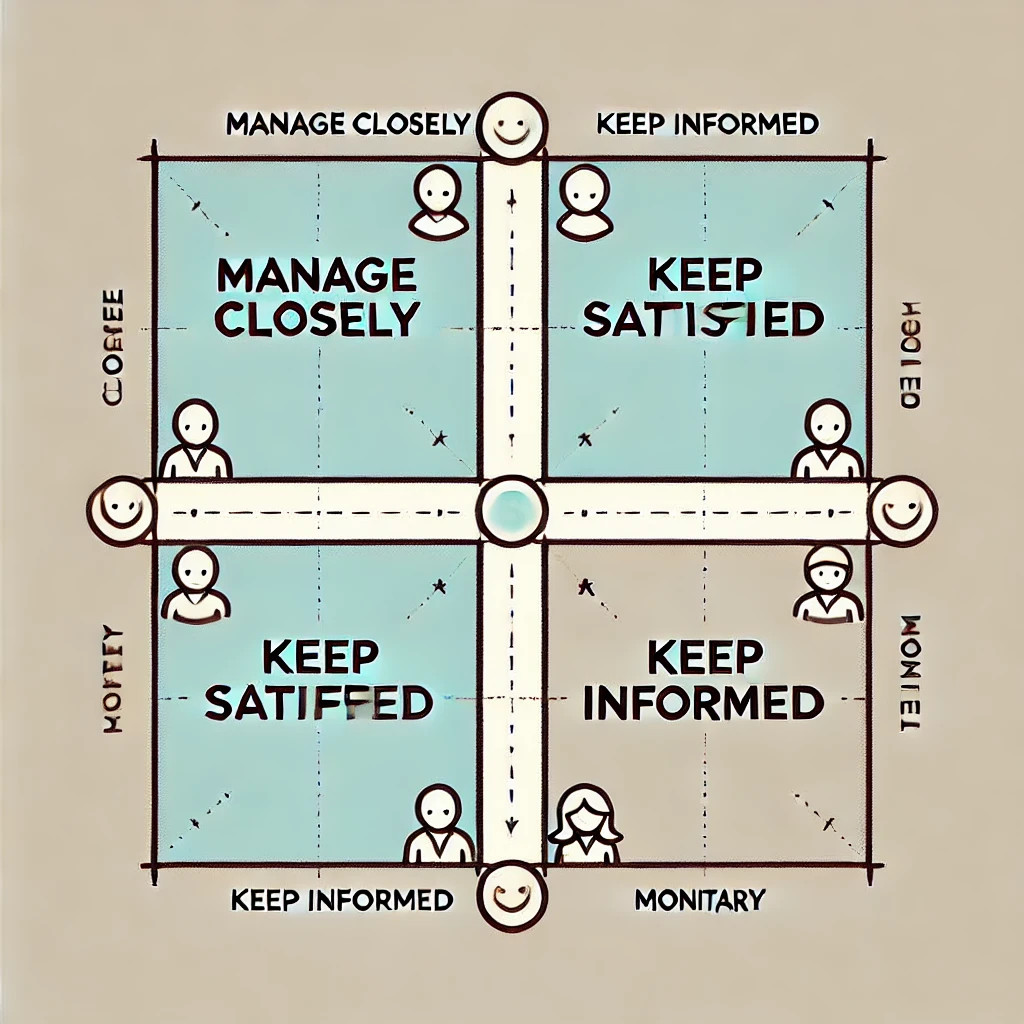In any project, whether small or large, stakeholders play a crucial role in shaping the outcome. Stakeholders include anyone who is affected by or can influence the project’s success. Managing these relationships effectively is essential for smooth project delivery, and one of the most effective tools to achieve this is the Stakeholder Engagement Grid.

The Stakeholder Engagement Grid allows project managers to categorize stakeholders based on their power to influence the project and their interest in its outcome. This tool helps in tailoring communication and engagement strategies based on the unique role each stakeholder plays.
What is the Stakeholder Engagement Grid?
The Stakeholder Engagement Grid is a visual framework used to map stakeholders into four categories based on two key attributes:
- Power: The stakeholder’s ability to influence the project’s direction or decisions.
- Interest: The level of concern or involvement the stakeholder has with the project’s outcomes.
These two dimensions help us decide how to engage each stakeholder effectively. By positioning each stakeholder on the grid, project managers can devise a personalized strategy for communication and engagement.
The Four Quadrants of the Stakeholder Engagement Grid
Stakeholders are grouped into four main categories, each requiring a distinct engagement strategy:
- High Power, High Interest – Manage Closely
- Who are they? These are stakeholders with a significant amount of power and a deep interest in the project’s outcomes. They can greatly influence the project’s success, and their engagement is critical.
- Engagement Strategy: You need to manage these stakeholders closely. Regular communication, involving them in key decisions, and keeping them updated on progress is essential to ensure their support.
- Example: Senior executives, project sponsors, or key customers.
- High Power, Low Interest – Keep Satisfied
- Who are they? These stakeholders have the power to influence the project but are not as interested in its day-to-day operations. Their satisfaction is crucial to avoid negative impacts, but they don’t need frequent updates.
- Engagement Strategy: Keep them informed about major milestones and deliverables, but avoid over-communicating. The goal is to ensure they remain satisfied without overwhelming them with unnecessary details.
- Example: Regulatory authorities, major investors, or company board members.
- Low Power, High Interest – Keep Informed
- Who are they? These stakeholders have a vested interest in the project’s success but lack the power to directly influence its outcomes. They are typically end-users or junior team members.
- Engagement Strategy: Keep them informed through regular updates. Their interest can make them vocal advocates for the project, so it’s important to ensure they feel involved and heard, even if they have less influence.
- Example: End-users, operational teams, or internal employees.
- Low Power, Low Interest – Monitor
- Who are they? These stakeholders have minimal interest in the project and little to no power over its outcomes. They don’t require much attention but should be monitored in case their status changes.
- Engagement Strategy: These stakeholders only need occasional updates. Simply monitor them to ensure their needs are met if they arise but avoid frequent engagement unless their role shifts.
- Example: External suppliers with minimal impact or peripheral stakeholders.
How to Use the Stakeholder Engagement Grid Effectively
Here’s a step-by-step guide to creating and using the Stakeholder Engagement Grid for your projects:
- Identify Stakeholders: Start by identifying all potential stakeholders. These could be individuals, departments, or organizations affected by the project or capable of influencing it.
- Assess Power and Interest: Evaluate each stakeholder’s level of power and interest in the project. Place them in the appropriate quadrant of the grid.
- Develop Engagement Strategies: Once you’ve categorized your stakeholders, tailor your engagement strategy to their position on the grid:
- Manage Closely: Frequent and deep involvement, constant communication, and decision-making power.
- Keep Satisfied: Provide key updates at significant milestones, and involve them in strategic decisions.
- Keep Informed: Regular communication and updates to keep them engaged.
- Monitor: Occasional updates, keep an eye on their involvement but don’t over-communicate.
- Monitor and Adjust: Stakeholders’ interest and power can change over time. Make sure to revisit the grid periodically and adjust your strategy as needed. A shift in a stakeholder’s position can drastically alter their role in the project.
Benefits of the Stakeholder Engagement Grid
- Prioritization: Helps in identifying which stakeholders require the most attention and resources.
- Tailored Communication: Allows you to customize communication strategies based on the needs of different stakeholders.
- Risk Mitigation: Proactively managing high-power stakeholders reduces the risk of opposition or conflict.
- Improved Collaboration: Encourages smoother relationships by ensuring stakeholders are engaged at the right level.
Conclusion
The Stakeholder Engagement Grid is a vital tool for project managers looking to foster strong stakeholder relationships. By categorizing stakeholders based on their power and interest, you can focus your efforts where they are needed most, ensuring project success and minimizing the chances of stakeholder dissatisfaction.
Using this simple grid can be the difference between a project that runs smoothly and one that faces constant hurdles. The next time you’re faced with managing a project, take the time to map out your stakeholders—it’ll save you time and effort in the long run.
